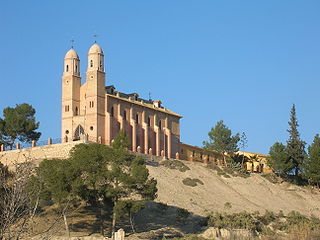
Cantabria is an autonomous community and province in northern Spain with Santander as its capital city. It is called a comunidad histórica, a historic community, in its current Statute of Autonomy. It is bordered on the east by the Basque autonomous community, on the south by Castile and León, on the west by the Principality of Asturias, and on the north by the Cantabrian Sea.

The Chachapoyas, also called the "Warriors of the Clouds", was a culture of the Andes living in the cloud forests of the southern part of the Department of Amazonas of present-day Peru. The Inca Empire conquered their civilization shortly before the Spanish conquest in the 16th century. At the time of the arrival of the conquistadors, the Chachapoyas were one of the many nations ruled by the Incas, although their incorporation had been difficult due to their constant resistance to Inca troops.

Cieza is a town and municipality in Spain, in the autonomous community of Murcia. It is the capital of the Vega Alta comarca, an old form of provincial subdivision). Its current population consisted of 34,889 inhabitants in the year 2018. The Segura River passes by the town.

Pedro Cieza de León was a Spanish conquistador and chronicler of Peru and Popayán. He is known primarily for his history and description of Peru, Crónicas del Perú. He wrote this book in four parts, but only the first was published during his lifetime; the remaining sections were not published until the 19th and 20th centuries.
The Regionalist Party of Cantabria is the second oldest political party in the Spanish Autonomous Community of Cantabria. The PRC originated in the Association in Defense of the Interests of Cantabria (ADIC), founded on 14 May 1976, with the objective of promoting Cantabrian autonomy.

Torrelavega is a municipality and important industrial and commercial hub in the single province Autonomous Community of Cantabria, northern Spain.

The Autovía A-33 is a proposed highway in Murcia, Spain between Cieza and Font de la Figuera. It follows or is an upgrade of the N-344 and will link the Autovía A-30 east of Cieza with the Autovía A-31/Autovía A-35 at Font de la Figuera north east of Murcia. It passes via Jumilla and Yecla over the Sierra del Buey close to the Puerto de Jumilla (810m).
The Divisiones Regionales de Fútbol in the Cantabria, are organized by the Cantabrian Football Federation:

Guaqui is a railhead and port in Bolivia on Lake Titicaca. A ferry connects with the Peruvian railhead and port on Puno. It served as location of Inca ruins prior to the arrival of the Spanish. The towns current church sites on what was the ancient ruins.

Rayo Cantabria, formerly known as Real Racing Club de Santander "B" is the reserve team of Racing de Santander, a Spanish football team based in Santander, in the autonomous community of Cantabria.
The season 1993–94 of Segunda División B of Spanish football started August 1993 and ended May 1994.
"Himno a la Montaña", or "Himno de Cantabria", is the official anthem of the Spanish autonomous community of Cantabria. It was composed in 1926 by Juan Guerrero Urresti at the behest of the then Provincial Council of Santander and subsequent arrangements by José del Río Sainz, in the region's official anthem.
The 1950–51 Tercera División was the 15th edition of the Spanish third tier.
The 2013 Tercera División play-offs to Segunda División B from Tercera División were the final playoffs for the promotion from 2012–13 Tercera División to 2013–14 Segunda División B. The first four teams in each group took part in the play-off.

Saja-Besaya Natural Park is Cantabrias largest natural park on the northern slope of the Cantabrian Mountains in West Central Cantabria, Spain. Its hunting reserve is approximately 1800km², the largest and most important in Spain.
Javier Antonio Cabello Rubio is a Spanish football manager, currently an assistant for FC Dallas.
Isaac "Isi" Palazón Camacho is a Spanish professional footballer who plays as a right winger for La Liga club Rayo Vallecano.

The 2023 Cantabrian regional election was held on Sunday, 28 May 2023, to elect the 11th Parliament of the autonomous community of Cantabria. All 35 seats in the Parliament were up for election. The election was held simultaneously with regional elections in eleven other autonomous communities and local elections all throughout Spain.













